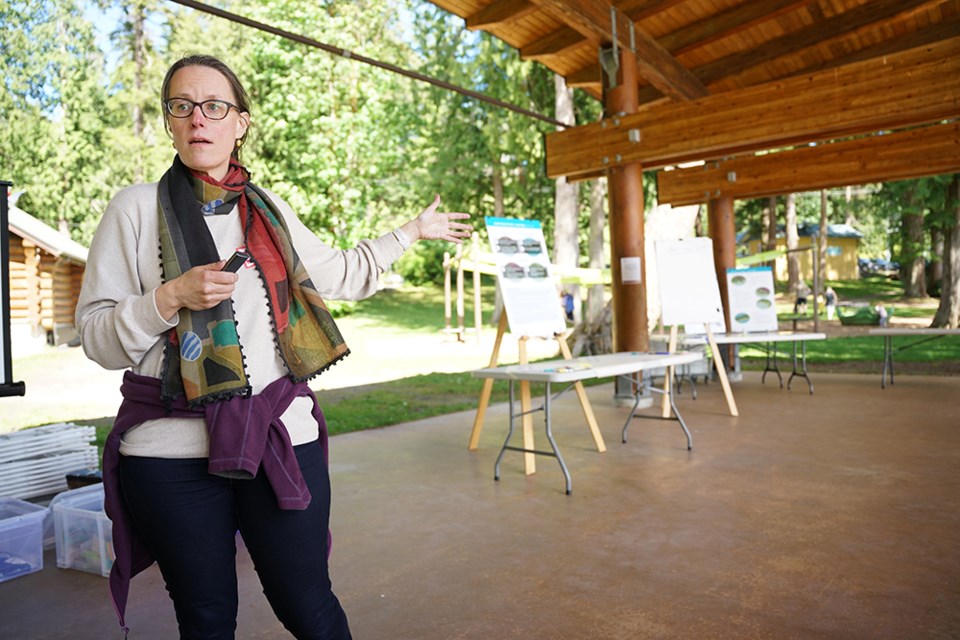A regional coastal flood adaptation strategy being coordinated by the three local governments was highlighted at a recent workshop, outlining flood hazards and strategies to adapt.
At a public information session at the Willingdon Beach pavilion, those in attendance were provided an overview of the project and steps taken to develop strategies, as well as being able to view storyboards created for the event.
Tamsin Lyle, an engineer and principal with Ebbwater Consulting Inc, which is helping coordinate the strategy for qathet Regional District, City of Powell River and Tla’amin Nation, said she was providing an overview of things that need to be thought about regarding the complexity of the problem, so that moving forward, good decisions can be made. Funding for the project came from the province.
Lyle said part of the strategy involves informing the public about what is going on with climate change and sea level rise, and coastal erosion in particular, to ensure there is good understanding.
She has been working on the project for about six months, and the three governments have been working on coastal adaptation for longer. The first goal is to understand mapping and the hazards, and what sea level rise looks like in the region, she added. That part of the project is complete.
“We’re currently working out figuring the ‘now what,’” said Lyle. “We know where the water is going and we want to understand what that means to us as a community and what we can do about it moving forward.”
Lyle said flooding has been prominent in the news of late. On the coast, she said there’s a lot going on in the ocean, with combinations of tides and storms.
“Along the coast it creates different types of hazards,” added Lyle. “You can get high waters or surges, with waves coming in and having a lot of energy, which creates damage along the shore and to the things we care about.
“We need to think about how water interacts with the shoreline in terms of erosion. We understand all of the nuances and how they play out.”
Lyle said one of the key messages is that floods are nuanced and have character. She said there has to be an understanding of the nuance to respond to it so the right choices are being made at the right place at the right time.
Coastal communities
She said on top of the floods that have occurred, climate change is being experienced and when it comes to coastal flooding, ocean levels around the world are rising. Ice packs are melting and adding more water, and the waters are also warming, which creates water expansion, according to Lyle.
She said coastal communities are being told to plan for a one-metre sea level rise, but numbers suggest the number may be a little bit lower in the qathet region.
Lyle said one key message she wanted to get across is the concern about risk and how water interacts with things people care about. She said there are different impacts, such as human and environmental impacts. There is disruption, such as when rail lines are washed out, affecting supply chains.
“It’s a very complex web,” said Lyle. “The key message is it’s the risk that matters, not the water itself.”
Lyle said there is variation in risk across the regional district. She said it comes down to topography, and the areas that are flatter are more prone to flooding. The direction that property is facing is also a factor if it is more exposed to wind direction, she added.
“The relative flood level here compared to Courtenay/Comox or other places along the coast is relatively small,” said Lyle. “There are areas that are potential risks, but overall, there is limited actual risk of flooding.”
In terms of adaptation strategies, measures to be taken include to protect, avoid, retreat and accommodate, according to Lyle. Protecting is about things that can be done to stop water from interacting with the things people care about. Avoid is about things that can be done to make sure things are not put in hazardous places.
Lyle said retreat is about things that can be done to explore alternate locations to move infrastructure away from hazardous areas. Accommodate is about how homes are built, or how communities are built, to make sure they are resilient to being wet on occasions, according to Lyle.
In terms of resilience building, Lyle indicated this involves investing in awareness, preparedness and response as a community so people can work together to respond to challenges and bounce back from negative impacts.
“We need to recognize there are lots of different solutions, and also, that we want to have a mix of solutions for redundancy,” said Lyle.
More information can be found by going to qathet.ca/regional-coastal-flood-adaptation-strategy/.



